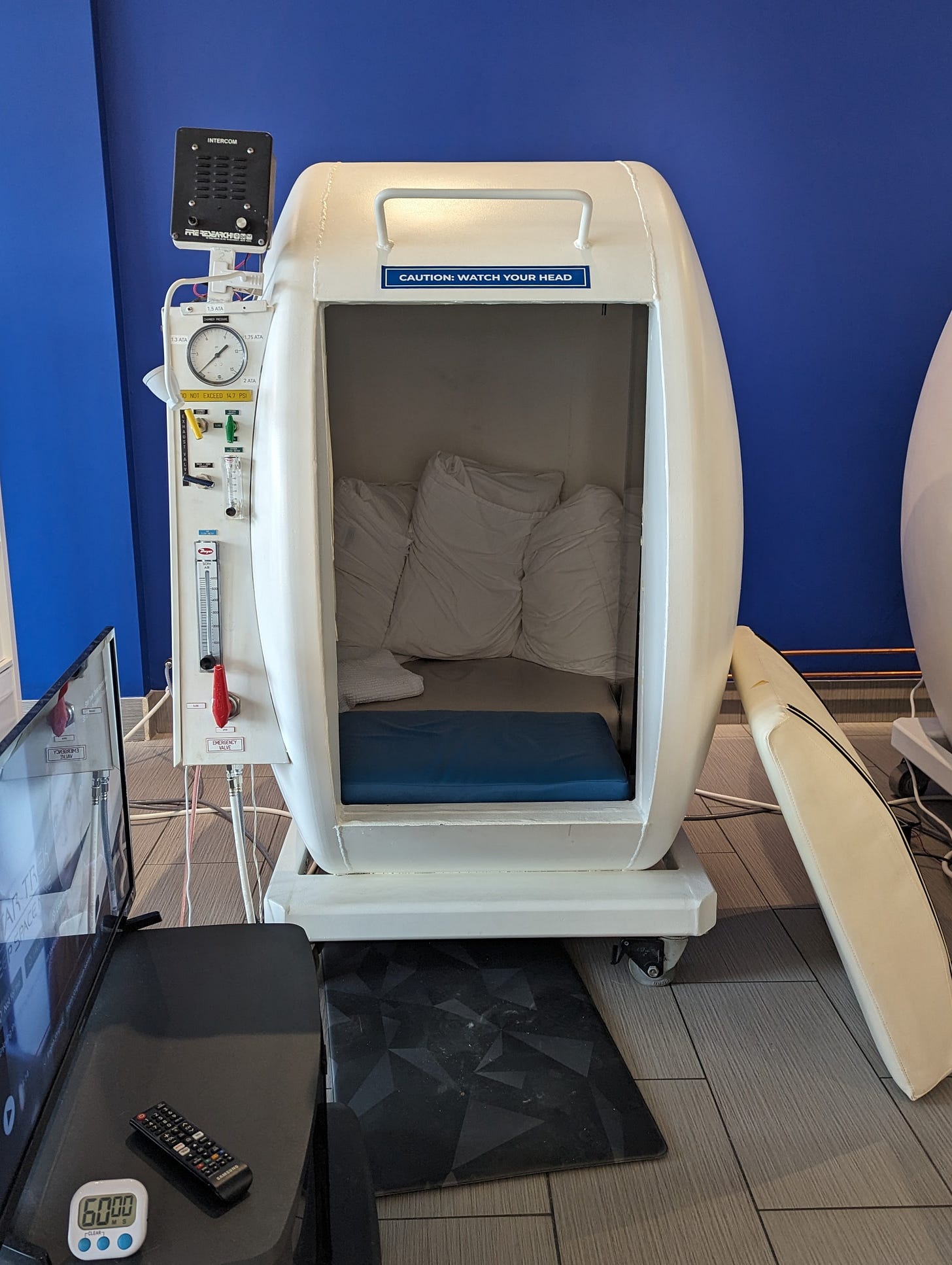Hyperbaric Oxygen Therapy
Healing at the cellular level with oxygen under pressure
When I first met the gentleman who runs the hyperbaric clinic I use in Vancouver, he didn’t have any visible disability or impairment. But a short couple of years ago, he was in a wheelchair, where he was told he would spend much of the rest of his life. His diagnosis? Multiple Sclerosis. Whether or not the diagnosis was correct is now in question: his biomarkers have almost all completely reversed. He doesn’t believe he has MS anymore, or whatever neurological condition he might have had.
Hyperbaric oxygen (HBOT) isn’t a miracle for everyone, and it carries a bit of risk, but it was a bit of a miracle for him. The more time you spend in a chamber, the more you might be able to expect at least some kind of gain in your body function as time passes. It reduces chronic inflammation, a cycle that can be tremendously difficult to break, and the root of chronic illness. It focuses on improving your cellular power centres—your mitochondria. After several rounds, the therapy induces the release of additional stem cells into your body.
Dr. Jason Sonners, in his book Oxygen Under Pressure, writes that chronic inflammation creates a cycle of metabolic dysregulation, immune dysregulation, oxidative stress, DNA damage, tissue damage, decreased blood flow, when then feeds back in to make inflammation even worse. It makes us feel old, fatigued, and irritable. Chronic health issues don’t target just one part of the body; HBOT, helps to break this cycle of decline.
From traumatic brain injury to tissue regeneration (wound healing), stroke, gut function, microvascular reformation, neuropathy, sensioneurlahearing hearing loss, fibromyalgia, and anti-cancer therapy, mold, to c. difficile, HBOT has a wide range of applications. The most common applications in clinical settings, though, are still limited to rarer problems like carbon monoxide poisoning, various pain syndromes, and thermal burns.
How it works
The technology is as simple as Dr. Sonners’ title: O2 under pressure. In an HBOT “dive,” you wear an oxygen mask in a sealed tank that bears an increase in pressure to 1.5, 2, or 3 atmospheres. For a TBI like mine, 1.5 seems to be the most popular pressure level. A session commonly lasts between 60 or 90 minutes.
The additional oxygen helps to improve our use of the main fuel for our cells, ATP. When we have chronic inflammation due to toxicity or damage, many parts of our body may be so deprived of oxygen that they become hypoxic. I have sometimes felt like I can’t get enough air, which might be a signal that my body isn’t using oxygen efficiently. Often patients and medical professionals alike will mischaracterize this as anxiety. If there’s tissue damage, it may be mild hypoxia.
Applications for me
For me, HBOT has a few obvious possible applications: brain tissue regeneration, improvement in gut function, and microvascular recovery. One of the biohackers I consult with from time to time believes that my use of medications in the past had collapsed much of my microvasculature. Some of my biomarkers seem to confirm this hypothesis.
Anybody on the path to healing needs to follow a recipe kind of like this:
remove sources of inflammation
upregulate basic function
improve energy and rest / engage parasympathetic mode
improve immune and gut function to lock in the upregulation
The last time I was in Vancouver, I did 8 sessions, and I had a good few weeks and months following that initial treatment. I just did 8 more, and I will do another 8 or so after a bit of a break. I had a bit of a symptom flare last week, so I decided to give it a break and cut out a few new things to see if it would make any difference. I happen to be simultaneously experimenting with peptides (BPC-157, microdosing GLP-1, and I’m about to start cerebrolysin, which improves brain function).
It’s common for folks to feel tired after treatment because the body has to expel all of the oxidated remnants (increased oxidation requires rest, and plenty of antioxidants + water). Plus, if my vasculature is as compromised as my biohacking colleague suggests, it makes sense that this therapy will tucker me out a bit more than most.
As for the requisite disclaimer, like any therapy, this one is not without any kind of risk. But the risks are modest, and the potential gains are multivariate and have a solid amount of evidence behind them. One of the big risks is oxygen toxicity to your CNS if you do too much of this good thing. Another is damage to your eyes and ears: it can accelerate cataract development for folks who are prone to them, and it can compromise your hearing if you can’t “pop your ears” deliberately (what I recently discovered is called the “toynebee maneuver").
One of the other discomforts, particularly for folks who are sick and whose body puts them into a physiological fight-flight response, is being confined in a tiny space. I had one or two fleeting moments like that, but as you settle into the routine, it becomes a meditative and calming environment where you can just rest, meditate, read, or watch a show. After I come out, I usually feel like a million bucks for a few hours, and then I have a nice deeeeep sleep. The following day, not so much.
So with 16 done and a handful more to go, I should be seeing some modest gains for the next while.



